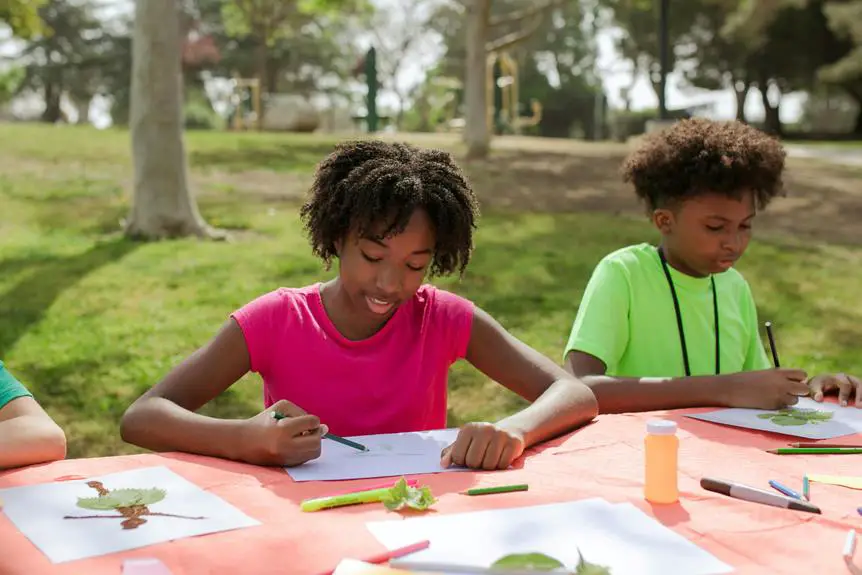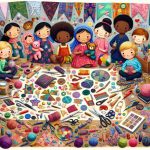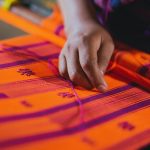When you think about stenciling for kids' crafts, you might envision a simple activity, but it's much more than that. By gathering the right supplies and choosing stencils that resonate with their interests, you can set the stage for creativity and skill development. Preparing a comfortable workspace and mastering a few techniques can make all the difference in your child's experience. So, what's the best way to ensure a smooth and enjoyable process? Let's explore some essential tips and project ideas that can elevate your stenciling sessions.
Table of Contents
Key Takeaways
- Choose age-appropriate stencils to match skill levels, using larger shapes for younger kids and intricate designs for older children.
- Prepare a clean and organized workspace with protective coverings to ensure a safe and enjoyable crafting experience.
- Use non-toxic and washable paints or markers to ensure safety and facilitate easy cleanup after the project.
- Secure stencils with painter's tape to prevent shifting during application and practice on scrap paper before starting.
What You Need for Stenciling
To get started with stenciling, you'll need a few essential supplies that make the process fun and easy.
First, gather your stencils. You can find a variety of shapes and designs at craft stores or even make your own using cardboard or plastic sheets.
Next, pick up some paint or ink. Acrylic paints work great because they're vibrant and easy to clean up. Don't forget a brush or sponge applicator to help apply the paint evenly.
You'll also need a surface to stencil on, like paper, canvas, or wood. Make sure it's clean and dry before you begin. A small piece of tape can help secure your stencil in place, preventing any unwanted shifts while you paint.
Lastly, keep some paper towels handy for quick clean-ups or mistakes.
With these supplies, you're ready to unleash your creativity!
Choosing the Right Stencils
Choosing the right stencils can make all the difference in creating fun and engaging crafts for kids. When selecting stencils, consider the age and skill level of the children involved. For younger kids, look for large, simple shapes that are easy to trace and color in. Animals, stars, and basic geometric forms are great choices. These designs encourage creativity without overwhelming them.
For older kids, you can introduce more intricate patterns, such as floral designs, letters, or themed stencils based on their interests. This allows them to explore their artistic abilities and tackle more complex projects.
Material is also crucial. Plastic stencils are durable and easy to clean, while cardboard stencils are lightweight and can be more affordable for one-time use. Additionally, think about the size of the stencils in relation to the project. Bigger stencils work well for larger surfaces, like poster boards, while smaller ones are perfect for cards or scrapbooking.
Lastly, consider the theme of your craft. Stencils that align with seasons, holidays, or specific interests can spark excitement and make the project more meaningful.
Choose wisely, and your crafting experience will be more enjoyable for everyone!
Preparing Your Workspace
Before you start stenciling, it's important to gather all the necessary materials to keep the process smooth.
Make sure you choose a suitable area with good lighting and enough space for you and your kids to work comfortably.
Don't forget to protect your surfaces and floors to avoid any messy accidents!
Gather Necessary Materials
Gather all your materials, ensuring you have everything you need for a smooth and enjoyable stenciling experience. Having the right supplies on hand not only makes the process easier but also helps keep the kids engaged and excited.
Here's a list of essential items you should gather before starting your stenciling project:
- Stencils: Choose designs that match your craft theme.
- Paint or Markers: Select colors that will make your artwork pop.
- Sponges or Brushes: Use these for applying paint evenly on the stencil.
Once you have these materials ready, you can easily transition into the creative phase of your project. It's a good idea to lay everything out within reach to avoid interruptions.
This setup won't only keep you organized but also encourage kids to take ownership of their craft. Remember, preparation is key to fostering a fun and productive crafting environment!
Choose a Suitable Area
A clean, well-lit workspace makes all the difference in keeping kids focused and inspired during your stenciling project.
Look for a table or desk with enough space to lay out your stencils, paints, and other materials. Good lighting is crucial, so if natural light isn't available, consider using a bright lamp to illuminate your area.
Make sure the space is free from distractions, like loud noises or clutter. This helps kids concentrate on their creations. If possible, designate a specific area for crafting to establish a routine and make cleanup easier later on.
You'll also want to consider seating. Make sure chairs are comfortable and at a height that allows kids to work without straining. You don't want them to get tired or fidgety halfway through their project.
Lastly, check the temperature of the room. A comfortable environment keeps everyone happy and engaged.
With these elements in place, you'll create an inviting atmosphere that encourages creativity and exploration. Prepare your workspace thoughtfully, and watch as your kids dive into their stenciling adventure with enthusiasm!
Protect Surfaces and Floors
To keep your workspace in top shape, lay down protective coverings on surfaces and floors before diving into your stenciling project. Kids can be messy, and accidents happen, so it's essential to safeguard your area against paint spills or marker smudges. Here's how to prepare effectively:
- Drop Cloths: Use old sheets or plastic drop cloths to cover tables and floors. They'll catch any unintended drips and keep everything clean beneath your project.
- Masking Tape: Secure the edges of your drop cloths with masking tape to prevent them from shifting while you work. This added stability will save you from potential messes.
- Paper Towels: Keep a roll of paper towels handy for quick clean-ups. You never know when a little spill might occur, and it's best to be prepared.
Stenciling Techniques for Kids
When you start stenciling with kids, having the right materials is key to a successful project.
You'll discover a variety of fun stenciling projects that can spark creativity and keep little hands busy.
Let's explore the basics and get ready for some exciting crafting!
Basic Stenciling Materials
Gathering the right basic stenciling materials is essential for creating fun and engaging crafts with kids. You'll want to ensure you have everything you need to make the process smooth and enjoyable.
Here's a list of must-have items that will help you get started on your stenciling adventure:
- Stencils: Choose various shapes, letters, and designs that capture your kids' interests. You can find them in stores or make your own using cardstock.
- Paint or Markers: Non-toxic paints or kid-friendly markers are perfect for filling in stencils. Consider washable options for easy cleanup.
- Brushes or Sponges: Depending on your paint choice, having a variety of brushes or sponges will help kids apply paint evenly.
Having these basic materials at hand sets the stage for creativity and exploration. Plus, it encourages kids to express their artistic side while developing fine motor skills.
Fun Stenciling Projects
Now that you've got your stenciling materials ready, it's time to explore some fun projects that will inspire kids to get creative and enjoy the art of stenciling. These projects are easy to set up and can be adapted to suit different ages and skill levels. Here are some ideas:
| Project | Description |
|---|---|
| T-Shirt Stenciling | Use fabric paint and stencils to create custom designs on plain t-shirts. Kids will love wearing their unique creations! |
| Stenciled Wall Art | Have kids choose their favorite shapes and create a fun collage on canvas or cardboard to hang in their room. |
| Greeting Cards | Kids can use stencils to decorate blank cards for birthdays, holidays, or just to say hello. It's a great way to express creativity! |
| Stenciled Planters | Let them stencil designs on flower pots using acrylic paint, making beautiful gifts for family and friends. |
These projects not only let kids express themselves but also help develop fine motor skills. Grab your stencils and get started on these exciting crafts today!
Fun Project Ideas to Try
Stenciling opens up a world of creative possibilities for kids, allowing them to transform ordinary materials into vibrant, personalized crafts. You can spark their imagination with a variety of fun project ideas that are easy to execute and sure to impress. Here are a few to get you started:
- Custom T-Shirts: Use fabric paint and stencils to create unique designs on plain shirts. Kids can wear their creations proudly!
- Decorative Canvas Art: Grab some canvases and acrylic paints. Let your kids stencil their favorite shapes or animals to make eye-catching wall art.
- Personalized Greeting Cards: Have your kids create custom cards for birthdays or holidays using stencils. They can add a personal touch by writing heartfelt messages inside.
Tips for a Smooth Experience
To ensure a successful stenciling experience, it's important to prepare your materials and workspace ahead of time. Gather all your supplies, including stencils, paints, brushes, and paper, so you won't waste time searching for items mid-project. Choose a clean, flat surface to work on, and cover it with newspaper or a drop cloth to protect against spills.
Before starting, do a test run on scrap paper. This helps you get a feel for the paint application and ensures the stencil adheres well. You might also want to secure the stencil with painter's tape to prevent it from shifting, especially if your kids are excitedly working together.
Keep a damp cloth nearby for quick clean-ups, as accidents can happen. When using paints, opt for washable varieties to make cleanup easier. Always encourage your kids to apply paint sparingly; too much can lead to smudging.
Frequently Asked Questions
Can Stencils Be Reused After Painting?
Yes, you can reuse stencils after painting. Just make sure to clean off any paint residue thoroughly. Once dry, they're ready for your next project, allowing you to create beautiful designs repeatedly without extra costs.
What Types of Paint Work Best for Stenciling?
For stenciling, acrylic paints work best due to their quick drying time and vibrant colors. Avoid water-based paints that may bleed under the stencil. Experiment with different finishes to achieve the desired effect in your projects.
Are There Age Restrictions for Using Stencils?
There aren't strict age restrictions for using stencils, but younger kids may need supervision and assistance. As they grow, they'll gain more independence and skills, making stenciling a fun and creative activity for all ages.
How Do I Clean Stencils After Use?
To clean stencils after use, rinse them under warm water immediately. If paint's dried, soak them in warm, soapy water for a bit. Gently scrub with a soft brush, then rinse and let dry.
Can Stencils Be Used on Fabric?
Yes, you can use stencils on fabric! Just make sure to secure them properly and use fabric paint or spray for best results. It'll give your projects a fun, personalized touch that really stands out.
- How Does Ring Spun Cotton Affect Garment Fit and Shape Retention? - August 13, 2024
- What Are the Challenges in Producing Ring Spun Cotton? - August 13, 2024
- Is Ring Spun Cotton Suitable for Plus-Size Clothing? - August 13, 2024







